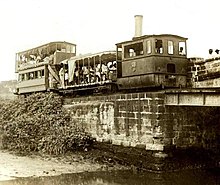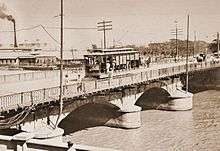Tranvia
The tranvía was a defunct streetcar system that served Manila and its surrounding cities during the early years of the 20th century.
| Tranvia | |||||||||||||||||||||
|---|---|---|---|---|---|---|---|---|---|---|---|---|---|---|---|---|---|---|---|---|---|
| Tranvía de Filipinas | |||||||||||||||||||||
_(14765708731).jpg) | |||||||||||||||||||||
| Operation | |||||||||||||||||||||
| Locale | Province of Manila (later City of Manila and Rizal), Philippines | ||||||||||||||||||||
| Open | 1888 | ||||||||||||||||||||
| Close | 1945 | ||||||||||||||||||||
| Status | Closed | ||||||||||||||||||||
| Owner(s) | Compañia de los Tranvías de Filipinas →Meralco | ||||||||||||||||||||
| Operator(s) | Compañia de los Tranvías de Filipinas →Meralco | ||||||||||||||||||||
| Infrastructure | |||||||||||||||||||||
| Track gauge | 1,435 mm (4 ft 8 1⁄2 in) standard gauge | ||||||||||||||||||||
| |||||||||||||||||||||
| |||||||||||||||||||||
History
Prior to the tranvia, modes of street transportation in Manila are mostly horse-drawn, consisting of the calesa, the lighter carromata, and the fancy caruaje.[1] The tranvia served as the first railway transport to run in the Philippines, as in its earliest years the Ferrocarril de Manila-Dagupan are in its planning stages.[2][3][4] The tranvia was renowned as "state-of-the-art" in East Asia, and had provided efficient transport to the residents of Manila.[5][6]
Compañia de los Tranvías de Filipinas

Plans for a tramway system came from the Formularios para la reducion de los anteproyectos de ferrocarriles, the same decree in 1875 that sparked the planning for the Ferrocarril de Manila-Dagupan. This was prepared by the Administracion de Obras Publicas to set construction conditions for potential railroad builders, from earlier railway regulations which utilizes animal power.
In 1882, a tramway company venture was founded by Jacobo Zóbel y Zangroniz, engineer Luciano M. Bremon, and banker Adolfo Bayo in line with Manila's growing populace, and thus construction for the tramway commenced. The first constructed tranvia line connected Manila to Malabon in 1884 and at the same time, this was opened to the public. The line proved to be a commercial success—both by estimation and usage—with a greater profit than wheeled traffic. The tramway provided a cheap, safe, and convenient means of transport within the city until the ouster of the Spanish regime by the US when tram services dwindled in maintenance and capacity.[7][2]:24, 25
Manila Electric, Rail, and Light Company
The United States established its governance in the Philippines in 1901. In the following year, a commission that called for franchise bids in operating a streetcar system alongside management of electricity was passed by five Americans and three Filipinos on October 20, 1902, known as Act No. 484. When Charles M. Swift won the bid for the Manila Electric Company franchise on March 24, 1903, he commissioned J. J. White for services in construction and engineering an electric tramway, and sometime in the following year, the Manila Electric Company acquired the Compañia de los Tranvías de Filipinas and the La Electricista.[5]
In 1913, under Swift's other franchise of "Manila Suburban Railway", a 9.8 km (6.1 mi) extension line that ran from Paco to Fort Mckinley and Pasig began operation.[3] This franchise merged with the Manila Electric, Rail, and Light Company in 1919, when it was then shortened to the familiar branding, Meralco.[8]:274[9] The tramway was then be powered by a steam power plant in Isla Provisora.[10]
On April 5, 1905, the tranvia was inaugurated. Although the terminology "streetcar" was favored by the American operators, locals still referred to the light railway as "tranvia".[3]
After the events of World War II and the Battle of Manila, the tranvia was left to a state of beyond economical repair. The tracks has since been dismantled, the remaining fleet scrapped, and the transport system within the metro shifted to automobile dependence and jeepneys.[4][11] Meralco has since been the sole electricity provider for Metro Manila and nearby provinces up to this date.[5]
Rolling stock
Throughout its existence, the tranvia utilized trams that differed mainly on propulsion. Under Spanish ownership, the tramway was noted for its horse-drawn coaches (tranvia de sangre), and under American rule, Meralco replaced the need for animal power by electrifying the tramways. All rolling stock ran on standard gauge light rail.
Steam-powered trams
Steam-powered trams ran exclusively through the Malabon Line.[7] The first fleet in the whole tranvia system and by propulsion consisted of four German-made light rail locomotives and eight passenger coaches.[6]
Horse-drawn carriages
Towards the end of the 19th century, Manila saw wheeled traffic powered by horses. As the popular power for land-based transport at that time, the secretary wrote that the Spanish tramway company was plagued with eccentric problems, mostly concerning the horses that pull the light rail coaches.[2] Each tram can carry 12 seated and 8 standing passengers, resembling an omnibus.[3]
Electrified trams
American ownership of the tramway under Meralco paved way for electrification, as the company also specializes on electricity distribution. The company designs and produces its own rolling stock in its workshops, and the maximum fleet of electricity-powered streetcars reached a total of 170 in 1924.[5] The streetcars utilize an overhead electrification system with a maximum of 500 volts.
Meralco also tinkered with trackless trolley buses, which subsequently replaced the streetcars plying Calle Santa Mesa between Rotonda and the San Juan Bridge.
Operations

The tramway system began construction in 1885 as an enterprise of Don Jacobo Zobel, the Compañia de los Tranvías de Filipinas. The Malabon Line was first to be accomplished in 1888, utilizing eight passenger coaches and four German-manufactured steam locomotives. Full operations opened in 1889 with the addition of lines serving Intramuros, Malate, Sampaloc, and Malacañan within Manila.[6][12] Unlike the Malabon Line, the trams that serviced within Manila are pulled by horses.[7]
The tramway was an hourly service in each direction, owing to popular demand. At the Malabon Line, the earliest services begin 5:30 a.m. and end at 7:30 p.m. from Tondo; trips from Malabon were from 6:00 a.m. until 8:00 p.m., a schedule met every hour at mornings, and every half-hour beginning at 1:30 p.m. in the afternoon.[13]
_(14574503429).jpg)
As the aftermath of the Filipino uprising and the American conquest, the tranvia was left in a poor state; in 1902, only ten horse-drawn cars service for a day.[10][3] Thus, ownership was passed under the Manila Electric, Rail, and Light Authority as Charles Swift won the bid for the streetcar operation. By the end of the year 1905, the system was inaugurated under Meralco's handling, and had around 63 km (39 mi) of light rail track. The streetcar system at that time connected Binondo, Escolta, San Nicolas, Tondo, Caloocan, Malabon, Quiapo, Sampaloc, Santa Mesa, San Miguel, and other areas within Metro Manila.[14] Under the American ownership, the light railroad workers are mostly Filipino.[8]:274
The tramway system gained line extensions, such as a line that runs from Santa Ana to Pasig, adding 11.6 km (7.2 mi) of railway length. Larger streetcars of double-wheel trucks and closed sides are added to the fleet, complementing the demand. In 1920, a five-year reconstruction program was undertaken for the 15-year old tramway, where newer streetcars are designed and manufactured by the company workshops; by 1924, the fleet consists of around 170 cars.[5]
Complementing Meralco's transportation businesses, autobuses are added in services as a streetcar system expansion was deemed "not economically viable". In 1927, 20 autobuses were manufactured. When World War II began in 1941, the streetcar fleet was reduced from 170 to 109 as the bus fleet was expanded to 190. The war was the major setback for Meralco for its transportation business, causing poor maintenance alongside the 1943 floods, including the Battle of Manila which saw the extensive destruction of the city of Manila and consequently, the streetcar system.[5][3][11]
Incidents
The horse-drawn coaches and the signalling often results to confusion, mostly from wrong handling of the animals, the tram failing to stop, or that of the whistle used by the Guardia Sibil tends to be taken as a signal which are replaced with trumpets.[2]:26
Despite the tranvia's notable patronage, operations had been marred with issues such as occasional strikes by Meralco streetcar workers.[15][16] A streetcar bombing incident once occurred while a strike was ongoing.[17]
Future
There had been plans to revive the tranvia. In 2019, a consortium led by Greenergy Holdings Inc. aimed to invest an amount close to $500 million in building a tram system along 10 km (6.2 mi) of the service road on Roxas Boulevard. This follows a route plied by the original tramway during the early 1900s. Under a joint venture agreement, the arrangement projects the tramway to serve as a passenger feeder to the Makati Intra-city Subway project.[18]
Light Rail Transit Line 1
The contemporary LRT–1, constructed in 1980, has a right of way that closely follows the tranvia's right-of-way somewhere from Manila going south to Pasay.[3]
Notes
- Track length under Meralco operations as of June 30, 1907.[8]:366
References
- Jose, Ricardo T. (August 25, 2018). "Planning Metro Manila's Mass Transit System". riles.upd.edu.ph. Retrieved May 28, 2020.
- Gonzalez, Michael Manuel (1979). The De Manila a Dagupan (PDF). Philippines: University of the Philippines Diliman.
- Satre, Gary L. (1998). The Metro Manila LRT System—A Historical Perspective (PDF) (Report). Japan Railway & Transport Review. Archived from the original (PDF) on May 5, 2006. Retrieved 18 November 2015.
- Lexis Nexis (1974). Mass Transit. PTN Pub. Co. Retrieved 2008-06-15.
- "100 Years with Meralco". meralco.com.ph. Meralco. October 11, 2004. Archived from the original on September 18, 2009. Retrieved May 28, 2020.
- Gamble, Adrian (March 10, 2017). "Manila's Long-Lost 'Tranvias' Once the Envy of Asia". skyrisecities.com. Skyrise Cities. Archived from the original on June 21, 2020. Retrieved June 21, 2020.
- Compania de los Tranvias de Filipinas (1885). Memoria y estatutos (Digitized book) (in Spanish). Madrid: Impr. de Fortanet. HE 3949 C65 A3. Lay summary.
- Secretary of Commerce and Police (1907). United States Congressional Serial Set. Philippine Commission. Retrieved June 23, 2020.
- "ELECTRICAL SERVICE IN THE PHILIPPINES; A 40,000 Horsepower Central Station Now Serves Manila and Suburbs. NEW PLAN BUILT IN 1905 Demand for Electric Lighting Grew Rapidly--6,000 Lamps in Streets Now. Pioneers on the Payroll. Nipa Hut Dwellers". New York Times. February 5, 1928. Retrieved April 25, 2017.
- "100 Years of Meralco: Colonial Outpost". meralco.com.ph. Meralco. October 11, 2004. Archived from the original on September 18, 2009. Retrieved May 28, 2020.
- "On trains, trams, and tranvias". businessmirror.com.ph. BusinessMirror Editorial. February 5, 2019. Archived from the original on June 21, 2020. Retrieved June 21, 2020.
- Corpuz, Arturo (May 1989). Railroads and regional development in the Philippines: Views from the colonial iron horse, 1875–1935 (Thesis). Cornell University. Retrieved June 20, 2020.
- de los Reyes, Isabelo (1890). "III". El folk-lore Filipino. University of the Philippines Press. Appendix "Malabon Monográfico".
- John Bach (1920). City of Manila, Philippine Islands (Map). Manila, Philippines. LCCN 2012586258. http://hdl.loc.gov/loc.gmd/g8064m.ct003077.
- Men on Strike (News clip photograph). Manila. Retrieved June 21, 2020.
- Streetcar Employees Seek To Enforce Wage Demands (News clip photograph). Manila. Retrieved June 21, 2020.
- Bomb Put Aboard Manila Street Car As Strike Is In Progress Injuries Seven (News clip photograph). Manila. Retrieved June 21, 2020.
- Doris Dumlao-Abadilla (October 2, 2019). "Revival of Manila tram system eyed". Philippines: Inquirer Business. Archived from the original on December 8, 2019. Retrieved June 21, 2020.
See also
- Meralco
- Philippine National Railways – the oldest extant railway system in the Philippines
- Corregidor – a fortified area within Cavite with a tramway system for military services
- Las Casas Filipinas de Acuzar – a heritage resort that features a short tram system alongside recreated bahay na bato structures in Bataan
- Line 1 – light rail successor of the tranvia system
- Jeepney – mode of transport that replaced the streetcar system after World War II